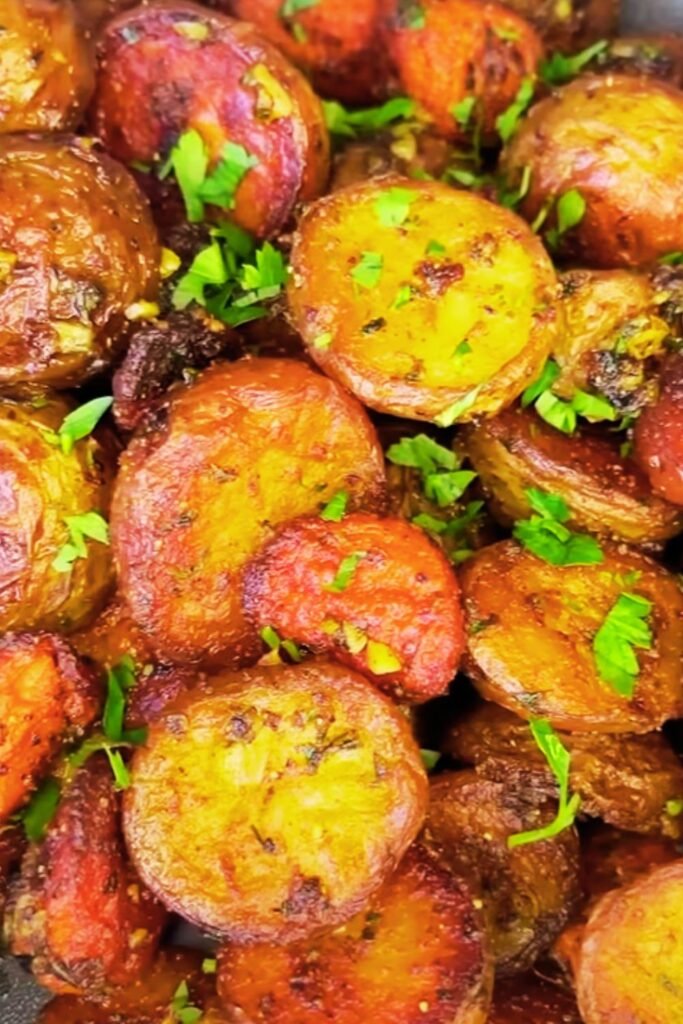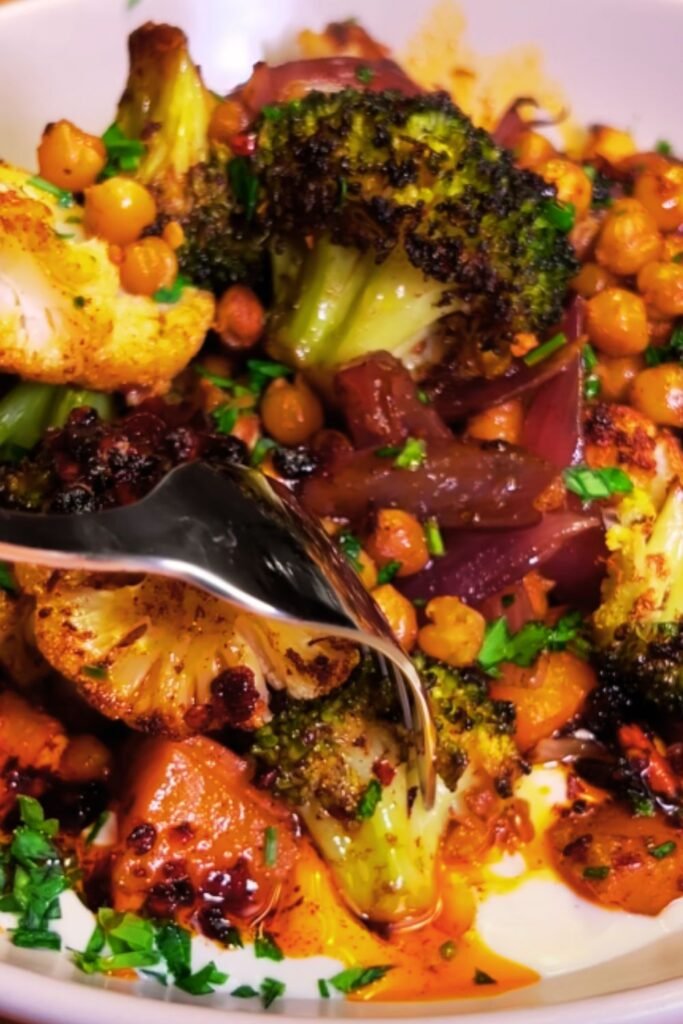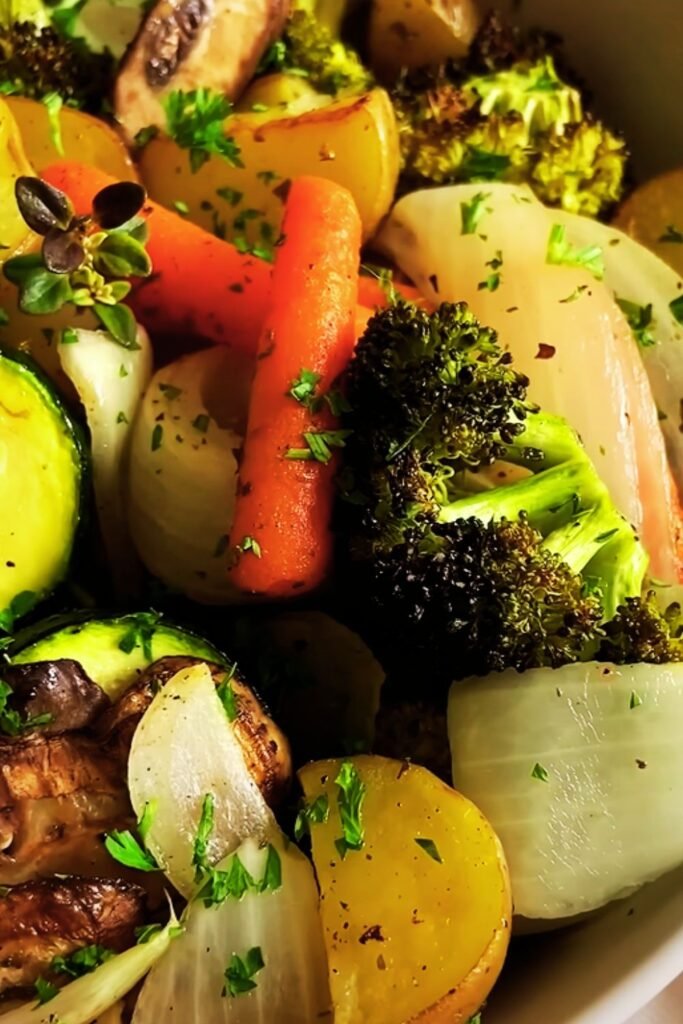I’ve been making roasted vegetables for years, and there’s something magical about the way simple ingredients transform in the oven. When I first started cooking, I thought roasted veggies were just a boring side dish. How wrong I was! Today, I’m sharing my favorite garlic herb roasted vegetable recipe that combines tender potatoes, sweet carrots, and fresh zucchini into a symphony of flavors that’ll make your taste buds dance.
The beauty of this dish lies in its simplicity and versatility. I’ve served this at dinner parties where guests couldn’t stop raving about the perfectly caramelized edges and the aromatic herb blend. Whether you’re a seasoned cook or just starting your culinary journey, this recipe will become your go-to side dish for any occasion.
Why I Love This Combination
After experimenting with countless vegetable combinations, I’ve found that potatoes, carrots, and zucchini create the perfect trio. The potatoes provide a hearty, satisfying base with their fluffy interior and crispy exterior. Carrots bring natural sweetness that intensifies during roasting, while zucchini adds a tender, mild flavor that absorbs all the wonderful herbs and garlic.
What makes this recipe special is the timing. Each vegetable has different cooking requirements, and I’ve perfected the technique to ensure everything finishes perfectly together. The key is understanding how each vegetable behaves in the oven and adjusting accordingly.
Essential Ingredients for Perfect Roasted Vegetables
Let me walk you through each ingredient and why it’s crucial for achieving restaurant-quality results at home.
Fresh Vegetables:
- Yukon Gold Potatoes: My preferred choice for their creamy texture and thin skin
- Large Carrots: Look for firm, vibrant orange carrots without soft spots
- Medium Zucchini: Choose zucchini that feels heavy for its size with unblemished skin
Aromatic Seasonings:
- Fresh Garlic: I use at least 4 cloves, minced finely for even distribution
- Fresh Rosemary: Nothing beats the piney, earthy flavor of fresh rosemary
- Fresh Thyme: Adds a subtle, lemony note that complements the other herbs
- Kosher Salt: Essential for drawing out moisture and enhancing flavors
- Black Pepper: Freshly ground makes a noticeable difference
Quality Oil:
- Extra Virgin Olive Oil: The foundation of flavor – don’t skimp on quality here
Nutritional Benefits That’ll Make You Feel Good
I love knowing that this delicious dish is packed with nutrients. Here’s a detailed breakdown of what you’re getting in every serving:
| Nutrient | Potatoes (1 medium) | Carrots (1 large) | Zucchini (1 medium) | Combined Benefits |
|---|---|---|---|---|
| Calories | 110 | 30 | 20 | Moderate calorie density |
| Vitamin C | 45% DV | 10% DV | 35% DV | Immune system support |
| Potassium | 620mg | 230mg | 295mg | Heart health, muscle function |
| Fiber | 2g | 2g | 1g | Digestive health |
| Vitamin A | 0% DV | 184% DV | 5% DV | Eye health, immune function |
| Folate | 12% DV | 5% DV | 8% DV | Cell division, DNA synthesis |
| Vitamin K | 2% DV | 8% DV | 5% DV | Blood clotting, bone health |
The combination provides a powerhouse of antioxidants, particularly beta-carotene from carrots and vitamin C from all three vegetables. I always feel good knowing I’m nourishing my body while enjoying incredible flavors.
Step-by-Step Preparation Guide

Prep Time: 15 minutes Cook Time: 35-40 minutes Total Time: 50-55 minutes Serves: 6-8 as a side dish
Ingredient List:
- 2 lbs Yukon Gold potatoes, cut into 1-inch cubes
- 1 lb large carrots, peeled and cut into 1-inch pieces
- 2 medium zucchini, cut into 1-inch pieces
- 4 cloves fresh garlic, minced
- 3 tablespoons fresh rosemary, chopped
- 2 tablespoons fresh thyme leaves
- 1/3 cup extra virgin olive oil
- 1 teaspoon kosher salt
- 1/2 teaspoon freshly ground black pepper
- Optional: 1/4 cup freshly grated Parmesan cheese
My Foolproof Method:
- Preheat and Prepare: I always start by preheating my oven to 425°F (220°C). This high temperature is crucial for achieving those beautifully caramelized edges I love so much.
- Vegetable Preparation: I wash and scrub the potatoes thoroughly, leaving the skin on for extra nutrition and texture. For the carrots, I peel them and cut them into uniform pieces. The zucchini gets a gentle wash and trim of the ends.
- Strategic Cutting: Here’s where experience matters. I cut the potatoes into 1-inch cubes, the carrots slightly smaller at 3/4-inch pieces since they take longer to cook, and the zucchini into 1-inch pieces since they cook fastest.
- Herb Preparation: I mince the garlic finely to ensure even distribution. For the herbs, I chop the rosemary finely since it can be tough, while the thyme leaves can be left slightly larger.
- The Assembly: In my largest mixing bowl, I combine the potatoes and carrots first with half the oil, salt, and pepper. I toss them well and spread them on a large rimmed baking sheet.
- Initial Roasting: I roast the potatoes and carrots for 20 minutes before adding the zucchini. This timing ensures everything finishes perfectly together.
- Final Assembly: After 20 minutes, I remove the pan and add the zucchini, remaining oil, garlic, and herbs. I toss everything together right on the pan to avoid transferring hot vegetables.
- Final Roasting: Back into the oven for another 15-20 minutes until the potatoes are golden and tender, and the zucchini is just cooked through.
Pro Tips for Restaurant-Quality Results

Through years of perfecting this recipe, I’ve discovered several secrets that make all the difference:
Temperature Control: I never go below 425°F. Lower temperatures steam the vegetables instead of roasting them, preventing that coveted caramelization.
Space Matters: I never overcrowd the pan. If needed, I use two baking sheets rather than cramming everything together. Overcrowding creates steam, which prevents browning.
Oil Distribution: I use my hands to ensure every piece is coated with oil. This might seem messy, but it’s the best way to ensure even coating.
Salt Timing: I salt the vegetables just before roasting. Salting too early draws out moisture, which can make vegetables soggy.
Fresh Herbs: I add fresh herbs in the last 15 minutes of cooking to prevent them from burning while still allowing their flavors to infuse the vegetables.
Serving Suggestions and Pairings
These roasted vegetables are incredibly versatile. I’ve served them alongside grilled chicken, pan-seared salmon, and even as a hearty vegetarian main course over quinoa or rice.
Perfect Protein Pairings:
- Herb-crusted chicken breast
- Grilled salmon with lemon
- Roasted pork tenderloin
- Baked cod with herbs
Vegetarian Main Course Ideas:
- Serve over creamy polenta
- Toss with cooked pasta and fresh basil
- Add to grain bowls with chickpeas
- Top with a fried egg for breakfast
Holiday Menu Integration:
- Thanksgiving alongside turkey and stuffing
- Christmas dinner with ham or roast beef
- Easter brunch with quiche
- Summer barbecues as a lighter side
Storage and Reheating Guidelines
I often make extra because these vegetables are fantastic as leftovers. Here’s how I handle storage and reheating:
| Storage Method | Duration | Quality Notes | Reheating Instructions |
|---|---|---|---|
| Refrigerator | 3-4 days | Maintains most texture | 350°F oven for 10-15 minutes |
| Freezer | 2-3 months | Texture changes slightly | Thaw overnight, then reheat |
| Room Temperature | 2 hours max | Food safety concern | Not recommended |
For best results, I reheat in the oven rather than the microwave to restore some of the original texture. If using the microwave, I add a splash of water and cover to prevent drying out.
Seasonal Variations I Love
One of my favorite things about this recipe is how adaptable it is throughout the year. Here are some seasonal twists I’ve developed:
Spring Variation: I substitute asparagus for zucchini and add fresh peas in the last 10 minutes of cooking.
Summer Abundance: I add cherry tomatoes and fresh bell peppers, reducing the cooking time slightly.
Fall Harvest: I incorporate sweet potatoes, butternut squash, and Brussels sprouts for a heartier dish.
Winter Comfort: I add parsnips and turnips, along with warming spices like sage and a touch of nutmeg.
Troubleshooting Common Issues

Over the years, I’ve helped many friends perfect their roasted vegetable technique. Here are the most common problems and my solutions:
Problem: Vegetables are mushy Solution: Higher temperature, less crowding, or shorter cooking time
Problem: Vegetables are burnt on outside, raw inside Solution: Lower temperature slightly, cut vegetables smaller, or cover with foil partway through
Problem: Bland flavor Solution: More salt, better oil quality, or fresher herbs
Problem: Uneven cooking Solution: Cut vegetables more uniformly, arrange in single layer
Problem: Vegetables are dry Solution: More oil, don’t overcook, or add herbs earlier
Make-Ahead Tips for Busy Weeknights
I’m always looking for ways to make weeknight cooking easier. Here’s how I prep this dish ahead:
- Vegetable Prep: I can wash, peel, and cut vegetables up to 2 days ahead. I store them in separate containers in the refrigerator.
- Herb Mixture: I combine the oil, garlic, and herbs up to 24 hours ahead and store in the refrigerator.
- Partial Cooking: I can roast the vegetables 75% of the way through, then finish them when ready to serve.
Frequently Asked Questions
Q: Can I use frozen vegetables for this recipe? A: While I prefer fresh vegetables for the best texture and flavor, you can use frozen vegetables in a pinch. Just thaw them completely and pat dry before roasting. The cooking time may be slightly less.
Q: What’s the best oil to use besides olive oil? A: I’ve had great success with avocado oil, which has a higher smoke point and neutral flavor. Coconut oil works too, but it will add a subtle coconut taste.
Q: How do I know when the vegetables are done? A: The potatoes should be golden brown and easily pierced with a fork. The carrots should be tender but still have a slight bite. The zucchini should be tender but not mushy.
Q: Can I add other vegetables to this mix? A: Absolutely! Bell peppers, onions, and Brussels sprouts work wonderfully. Just consider their cooking times and add them at the appropriate moment.
Q: My vegetables always come out soggy. What am I doing wrong? A: The most common cause is overcrowding the pan or using too low a temperature. Make sure vegetables are in a single layer and the oven is at least 425°F.
Q: Can I make this recipe dairy-free? A: This recipe is naturally dairy-free if you skip the optional Parmesan cheese. All the other ingredients are plant-based.
Q: How can I make this recipe more protein-rich? A: I sometimes add chickpeas or white beans in the last 15 minutes of cooking. You could also sprinkle with pine nuts or pumpkin seeds before serving.
Q: What herbs work best if I don’t have rosemary and thyme? A: Oregano, basil, and sage all work beautifully. I’ve also used herb blends like Italian seasoning or herbes de Provence with excellent results.
Q: Can I prepare this recipe on a grill? A: Yes! I use a large grill basket or heavy-duty foil. The cooking time is similar, but you’ll need to stir more frequently to prevent burning.
Q: How do I prevent the garlic from burning? A: I always add the garlic in the last 15-20 minutes of cooking. If you add it too early, it can become bitter from overcooking.
This garlic herb roasted vegetable recipe has become one of my most requested dishes. The combination of perfectly caramelized vegetables with aromatic herbs creates a side dish that’s both comforting and elegant. Whether you’re cooking for family dinner or entertaining guests, these roasted vegetables deliver every time. The best part? Once you master the basic technique, you can experiment with different vegetable combinations and seasonings to create your own signature version. I hope this recipe brings as much joy to your kitchen as it has to mine!